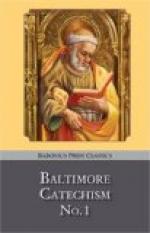“Scapulars.” The scapular is a large broad piece of cloth worn by the monks and priests of some of the religious orders. It extends from the toes in front to the heels behind, and is wide enough to cover the shoulders. It is worn over the cassock or habit. It is called scapular because it rests on the shoulders. The scapular as we wear it is two small pieces of cloth fastened together by two pieces of braid or cord resting on the shoulders. It is made thus in imitation of the large scapular, and is to be worn under our ordinary garments. The brown scapular is called the Scapular of Mount Carmel. It was given, we are told on good authority, to blessed Simon Stock by the Blessed Virgin herself, with wonderful promises in favor of those who wear it. The Church grants many privileges and indulgences to those who wear the scapular.
We wear the scapular to indicate that we place ourselves under the special protection of the Blessed Virgin. We can tell to what army or nation a soldier belongs by the uniform he wears; so we can consider the scapular as the particular uniform of those who desire to serve the Blessed Virgin in some special manner. This wearing of the brown scapular is therefore a mark of special devotion to the Blessed Virgin Mary. As it was first introduced among people by the Carmelite Fathers, or priests of the Order of Mount Carmel, this Scapular is called the Scapular of Mount Carmel. We have also a red scapular in honor of Our Lord’s Passion; a white one in honor of the Holy Trinity; a blue one in honor of the Immaculate Conception; and a black one in honor of the seven dolors of sorrows of the Blessed Virgin. When all these are joined together (not in one piece, but at the top only) and worn as one, they are called the five scapulars.
The seven dolors are seven chief occasions of sorrow in the life of our Blessed Lady. They are: (1) The circumcision of Our Lord, when she saw His blood shed for the first time. (2) Her flight into Egypt to save the life of the little Infant Jesus when Herod was seeking to kill Him. (3) The three days she lost Him in Jerusalem. (4) When she saw Christ carrying His Cross. (5) His death. (6) When He was taken down from the Cross. (7) When He was laid in the sepulchre. There are beads called seven dolor beads constructed with seven medals bearing representations of these sorrows, and seven beads between each medal and the next. At the medals we meditate on the dolor, and then in its honor say “Hail Marys” on the beads.
303 Q. Is there any other means of obtaining God’s grace than the Sacraments? A. There is another means of obtaining God’s grace, and it is prayer.
304 Q. What is prayer? A. Prayer is the lifting up of our minds and hearts to God to adore Him, to thank Him for His benefits, to ask His forgiveness, and to beg of Him all the graces we need whether for soul or body.




